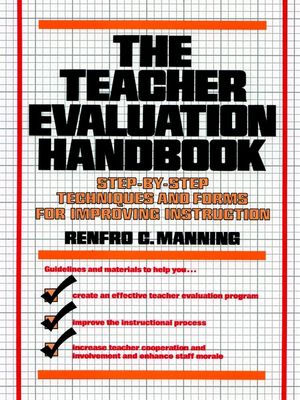The Teacher Evaluation Handbook: Step-by-Step Techniques and Forms for Improving InstructionISBN: 978-0-13-888389-8
Paperback
208 pages
June 1988, Jossey-Bass
 |
||||||
About This Book.
Chapter 1: Evaluation-- Growth or Harassment?
The Use of Formative and Summative Evaluation.
Mixing Formative and Summative Evaluation.
Eliminating the Problem of Dual Purposes.
Eliminating Confusion.
A Model for Evaluation.
Motivation and Evaluation.
Summary.
Chapter 2: What's Worth Evaluating.
Getting Started.
The Responsibilities of Local Research Units.
Examples of Professional Practices.
Considerations for Evaluation.
Constructing a Summative Instrument.
The Question of Generic or Content.
Examples of Professional Practices.
Summary.
Chapter 3: Peers as Evaluators.
Peer Selection and Turnover.
Should Peers Have Released Time?
Peers and School Reform.
Peer Observers and Teacher Unions.
Peer Observers and the New Teacher.
Summary.
Chapter 4: Training Evaluators.
The Training Focus.
A Method of Training.
Changing Traditional Reality.
Summary.
Chapter 5: The Evaluation Instrument as a Basis for Staff Development.
Curriculum Delivery Systems.
Staff Development and the Broad View.
Making Staff Development Work.
Making Change Permanent.
A Long-term Commitment.
Staff Development and the State.
The Continuing Battle.
Summary.
Chapter 6: Conferencing and Setting Performance Targets.
Determining the Purposes-- A Necessary First Step.
Improve Conference Skills and Improve Evaluation.
The Price of Failure.
Summary.
Chapter 7: Evaluation as a Terminal Activity.
Preparing to Win.
The No-Risk Win.
Suggestions for Documenting.
Helping the Administrator.
Who Are the Incompetent?
Documentation for E.E.O.C. Complaints.
Some Legal Aspects of Termination.
Summary.
Chapter 8: Evaluation as a Basis for Merit Pay.
Understanding Differentiated Pay.
The Problem with Student Achievement.
Initiating Differentiated Pay.
Differentiated Pay-- The Promise.
A Program that Works.
Summary.
Chapter 9: Summative Evaluations.
Identifying Those Who Need Summative Evaluation.
Designing the Summative Instrument.
Who Evaluates Summatively?
Valuing.
Summary.
Chapter 10: Putting It All Together.
What's the Goal (Purpose)?
What to Evaluate.
The Human Element.
Teaching Teachers.
The Central Focus.
Conferencing.
Go for the Long Term.
Summary.
Appendix.
Bibliography.
Index.
Chapter 1: Evaluation-- Growth or Harassment?
The Use of Formative and Summative Evaluation.
Mixing Formative and Summative Evaluation.
Eliminating the Problem of Dual Purposes.
Eliminating Confusion.
A Model for Evaluation.
Motivation and Evaluation.
Summary.
Chapter 2: What's Worth Evaluating.
Getting Started.
The Responsibilities of Local Research Units.
Examples of Professional Practices.
Considerations for Evaluation.
Constructing a Summative Instrument.
The Question of Generic or Content.
Examples of Professional Practices.
Summary.
Chapter 3: Peers as Evaluators.
Peer Selection and Turnover.
Should Peers Have Released Time?
Peers and School Reform.
Peer Observers and Teacher Unions.
Peer Observers and the New Teacher.
Summary.
Chapter 4: Training Evaluators.
The Training Focus.
A Method of Training.
Changing Traditional Reality.
Summary.
Chapter 5: The Evaluation Instrument as a Basis for Staff Development.
Curriculum Delivery Systems.
Staff Development and the Broad View.
Making Staff Development Work.
Making Change Permanent.
A Long-term Commitment.
Staff Development and the State.
The Continuing Battle.
Summary.
Chapter 6: Conferencing and Setting Performance Targets.
Determining the Purposes-- A Necessary First Step.
Improve Conference Skills and Improve Evaluation.
The Price of Failure.
Summary.
Chapter 7: Evaluation as a Terminal Activity.
Preparing to Win.
The No-Risk Win.
Suggestions for Documenting.
Helping the Administrator.
Who Are the Incompetent?
Documentation for E.E.O.C. Complaints.
Some Legal Aspects of Termination.
Summary.
Chapter 8: Evaluation as a Basis for Merit Pay.
Understanding Differentiated Pay.
The Problem with Student Achievement.
Initiating Differentiated Pay.
Differentiated Pay-- The Promise.
A Program that Works.
Summary.
Chapter 9: Summative Evaluations.
Identifying Those Who Need Summative Evaluation.
Designing the Summative Instrument.
Who Evaluates Summatively?
Valuing.
Summary.
Chapter 10: Putting It All Together.
What's the Goal (Purpose)?
What to Evaluate.
The Human Element.
Teaching Teachers.
The Central Focus.
Conferencing.
Go for the Long Term.
Summary.
Appendix.
Bibliography.
Index.



